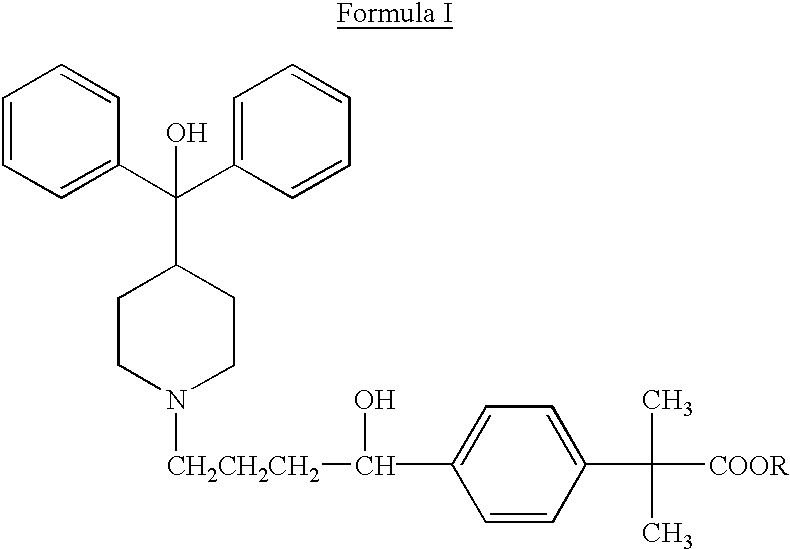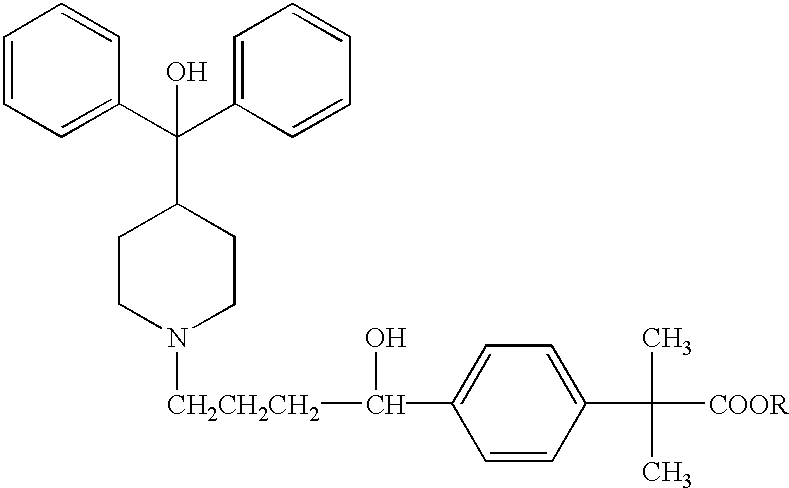Method of enhancing bioavailability of fexofenadine and its derivatives
- Summary
- Abstract
- Description
- Claims
- Application Information
AI Technical Summary
Benefits of technology
Problems solved by technology
Method used
Image
Examples
example 2
Effect of Water Suluble Vitamin E on the Bioavailability of Fexofenadine in the Dog
The effect of water soluble vitamin E (d-.alpha.-tocopheryl polyethylene glycol succinate) on the bioavailability of fexofenadine was determined in two fasted, male beagle dogs in two-way crossover experimental design. Treatment A consisted of oral administration of an aqueous solution of a 1 mg / kg dose of .sup.14 C-labeled fexofenadine alone, and Treatment B consisted of oral administration of an aqueous solution of the same dose of .sup.14 C-labeled fexofenadine and a 10 IU / Kg dose of water soluble vitamin E. Treatments were given in the opposing order of a crossover design in the two dogs, and a on week washout period occurred between treatments. The radioactivity in plasma and urine was analyzed and is known to represent unchanged fexofenadine in the dog. The results showed a 50% increase in plasma .sup.14 C AUC occurred when water soluble vitamin E was co-administered with .sup.14 C fexofenadine ...
example 3
Effect of PEG 1000 on the Bioavailabilty of Fexofenadine in the Dog
The effect of polyethylene glycol 1000 (PEG 1000) on the bioavailability of fexofenadine was determined in two fasted, male beagle dogs. Treatment A consisted of oral administration of one 120 mg fexofenadine hydrochloride sustained release (SR) tablet, and treatment B consisted of oral administration of one SR tablet together with a capsule containing 0.5 g PEG 1000 dissolved in 2.5 mL water given at -1, -0.1, and 4 hours before and after the SR tablet. Treatment A was given two months prior to Treatment B. The plasma concentrations of fexofenadine were analyzed to determine relative bioavailability of fexofenadine with and without concomitant treatment with PEG 1000.
A mean 2-fold increase in plasma concentrations [AUC(0-24h) values calculated from the concentrations shown in Table IV] occurred when PEG 1000 was co-administered with fexofenadine. The peak concentration was increased a mean of 3-fold. This increased ...
PUM
| Property | Measurement | Unit |
|---|---|---|
| Water solubility | aaaaa | aaaaa |
| Bioavailability | aaaaa | aaaaa |
Abstract
Description
Claims
Application Information
 Login to View More
Login to View More - R&D
- Intellectual Property
- Life Sciences
- Materials
- Tech Scout
- Unparalleled Data Quality
- Higher Quality Content
- 60% Fewer Hallucinations
Browse by: Latest US Patents, China's latest patents, Technical Efficacy Thesaurus, Application Domain, Technology Topic, Popular Technical Reports.
© 2025 PatSnap. All rights reserved.Legal|Privacy policy|Modern Slavery Act Transparency Statement|Sitemap|About US| Contact US: help@patsnap.com



